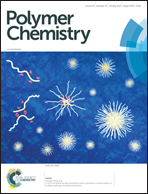Polymerization induced self-assembly: tuning of morphology using ionic strength and pH†
Abstract
Investigations of RAFT dispersion polymerization-induced self-assembly (PISA) of 2-hydroxypropyl methacrylate (HPMA) in water/methanol at 60 °C using a cationically charged macroRAFT agent as the stabilizer block, namely P(N,N-diethylaminoethyl methacrylate)-stat-poly((ethylene glycol) methyl ether methacrylate) (PDEAEMA-stat-PEGMA), have been conducted with a view to tune particle morphologies by manipulation of the pH and the ionic strength. Above the LCST (45 °C) of (PDEAEMA-stat-PEGMA), the system can only be conducted as a dispersion polymerization at sufficiently low pH such that the stabilizer block is sufficiently protonated to ensure solubility in the continuous phase. It is demonstrated (reported in the form of an extensive morphology diagram) that a range of morphologies including spherical particles, rods and vesicles can be accessed by adjustment of the pH (via addition of HCl) and the ionic strength (via the concentration of NaCl). A decrease in the charge density of the coronal stabilizer layer via an increase in the pH (less protonation) shifts the system towards higher order morphologies. At a given pH, an increase in ionic strength leads to more extensive charge screening, thus allowing formation of higher order morphologies.



 Please wait while we load your content...
Please wait while we load your content...